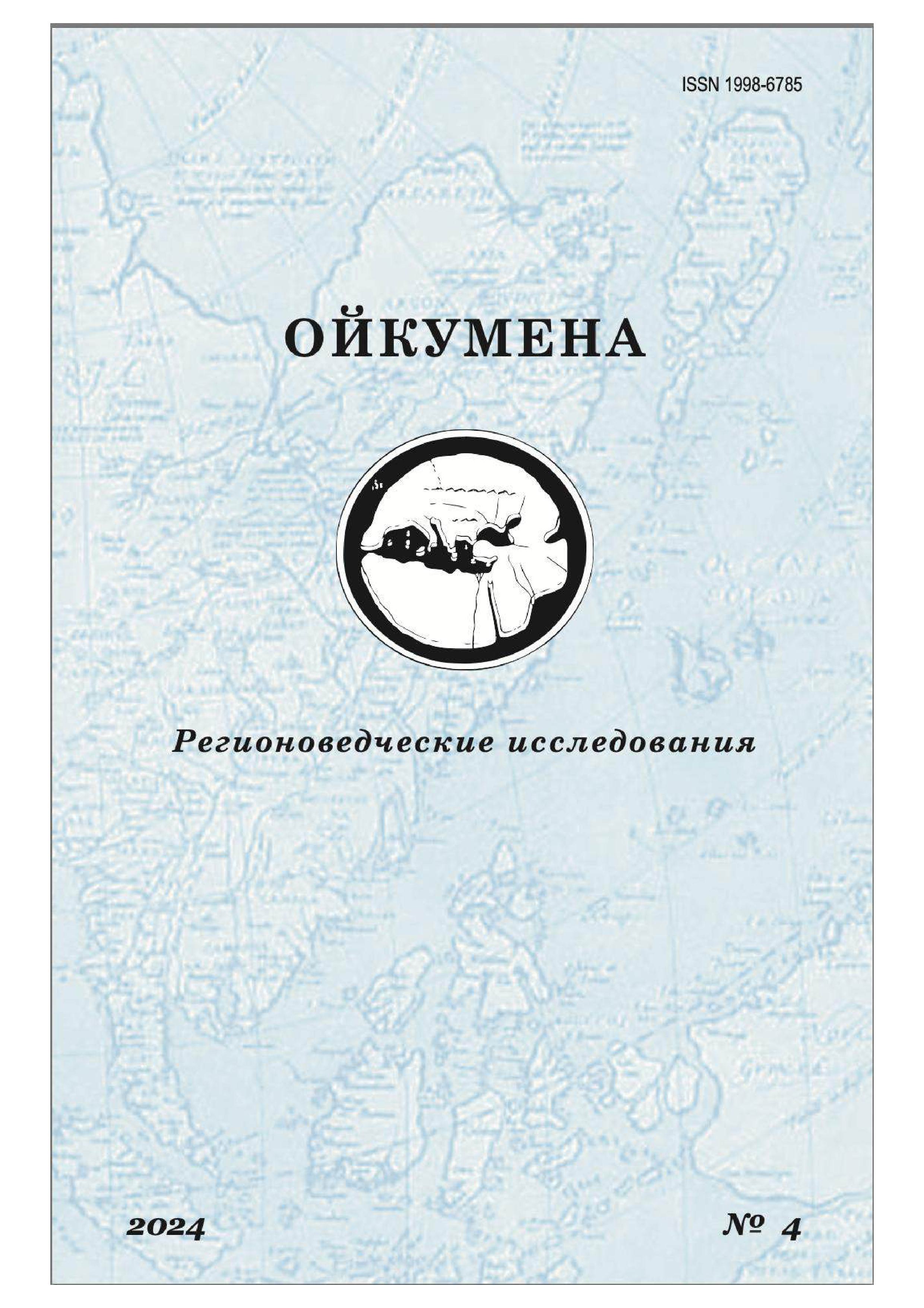employee
Vladivostok, Russian Federation
The purpose of the article is to identify the influence of ethnic values on the strategies of ethnosocial behavior of mestizos of Khakassia in the context of contemporary social development. The study is based on an integrated ap- proach relying on statistical data, secondary sociological analysis. Survey methods (questionnaire, informal interview) were also used. In the course of the study, the main socio-demographic characteristics of the mestizos of Khakassia were identified, their main ethnic values were determined taking into account the markers of ethnic identity, and the main strategies of ethnosocial behavior were described. The research we have undertaken allows us to expand our understanding of the place and role of mestizos in the interethnic space of Khakassia, which in the long term may contribute to the development of an optimal regional concept for the development of ethnosocial processes, as well as a set of measures to preserve the Khakass language and culture
ethnic values, ethnic identity, ethnosocial processes, behavioral strategies, mestizos, Republic of Khakassia
1. Anzhiganova L. V., Topoeva M. V. "New ethnicity": theoretical aspects of the study // Thesauruses and problems of culture: materials of the all-Russian (national) scientific conference with international participation (Moscow, 4 April 2019). M.: Moscow University for the Humanities, 2019. P. 281–292. (In Russ.).
2. Barth F. Ethnic groups and social boundaries. Moscow: New Publishing House, 2006. 200 p. (In Russ.). EDN: https://elibrary.ru/QOFQWB
3. Moscow: Medium, 1995. 323 p. (In Russ.).
4. Berger P., Luckmann T. Social construction of reality: a treatise on the sociology of knowledge. Bromley Yu. V. Ethnosocial processes: theory, history, modernity. Moscow: Science, 1987. 333 p. (In Russ.).
5. Language proficiency and use of languages by the population. Results of the All-Russian Population Census 2020. Vol. 5. National compound and language proficiency // Federal State Statistics Service. URL: https://rosstat.gov.ru/vpn/2020/Tom5_Nacionalnyj_sostav_i_vladenie_yazykami (accessed 20.08.2024). (In Russ.).
6. Impact of family education systems of contemporary diasporas on social well-being and education of children (based on the example of the South Siberian Region)/ Sultanbaeva O. F., Gorbunova T. A., Dorofeeva M. Ya., Dobrya M. Ya., Efimova O. E. Abakan: Khakass State University, 2022. 160 p. (In Russ.). EDN: https://elibrary.ru/RIDEKF
7. Galindabaeva V. V. "Sometimes I’m Russian, and sometimes I’m Buryat": strategies for constructing "mixed race" among the youth of Buryatia // Contemporary youth communities in culture and politics. Collected scholarly papers. Kostyushev V. V. (ed.). St. Petersburg: Norma, 2008. P. 12–26. (In Russ.).
8. Garfinkel H. Studies in Ethnomethodology. St. Petersburg: Piter, 2007. 335 p. (In Russ.).
9. Iskhakova F. S. Formation of tolerance in the educational process // Bulletin of Ufa State University of Economics and Service. Science, Education, Economics. Series: Economics. 2015. No. 1 (11). P. 189–192. (In Russ.). EDN: https://elibrary.ru/TOUEBV
10. Results of the 2020 All-Russian Population Census in the Republic of Khakassia // Office of the Federal State Statistics Service for Krasnoyarsk Territory, Republic of Khakassia and Republic of Tuva. URL: https://www.krasstat.gks.ru/storage/mediabank/%D0%94%D0%BE%D0%BA%D0%BB%D0%B0%D0%B4%20%D0%92%D0%9F%D0%9D%20-%20%D0%A0%D0%A5.pdf (accessed 12.02.2024). (In Russ.).
11. Kalieva A. T. Ethnic values as an object of social and humanitarian knowledge // Bulletin of the Orenburg State University. 2009. No. 7 (101). P. 167–171. (In Russ.). EDN: https://elibrary.ru/KYFDXT
12. Kostyuk V. G., Goncharova G. S. The relationship between ethnic types of families and interethnic interactions in contemporary Russia // Bulletin of the Novosibirsk State University. Series: Philosophy. 2015. Vol. 13. Issue. 4. P. 105–111. (In Russ.). EDN: https://elibrary.ru/VIYUAV
13. Krivonogov V. P. National-mixed marriages and miscegenation among indigenous minorities. Krasnoyarsk: Siberian Federal University, 2023. 308 p. (In Russ.). EDN: https://elibrary.ru/ZSWTSO
14. Labunskaya V. A., Bzezyan A. A. Features of the "appearance" of stereotypes of ethnocultural groups with different types of appearance // East European Scientific Journal. 2016. No. 11. P. 106–113. (In Russ.).
15. Okladnikova E. A. Ethnosociology (Theory of Ethnic Values). St. Petersburg: St. Petersburg State University of Engineering and Economics, 2006. 170 p. (In Russ.). EDN: https://elibrary.ru/QOGKIP
16. Ryzhova S. V. Ethnic identity and tolerance in a multicultural society: an all-Russian perspective and research in Kabardino-Balkaria // Sociologicheskaja nauka i social’naja praktika. 2023. Vol. 11. No. 4. P. 156–177. (In Russ.). DOI: https://doi.org/10.19181/snsp.2020.8.3.7497; EDN: https://elibrary.ru/QSYUIP
17. Ryzhova S. V. Ethnic identity in the social dimension // Sociologicheskaja nauka i social’naja praktika. Vol. 8. No. 3. P. 165–181. (In Russ.). DOI: https://doi.org/10.19181/snsp.2023.11.4.7; EDN: https://elibrary.ru/AIFYWD
18. Strauss A., Korbin J. Basics of Qualitative Research: Grounded Theory Procedures and Techniques. Moscow: Editorial URSS, 2001. 256 p. (In Russ.).
19. Tinikova E. E. Ethnosocial processes in the Republic of Khakassia: dynamics and development trends (based on expert survey materials) // Ojkumena. Regional researches. 2024. No. 1. P. 11–19. (In Russ.). DOI: https://doi.org/10.24866/1998-6785/2024-1/11-19; EDN: https://elibrary.ru/NEYYNO
20. Flier A. Ya. Ethnic values. In: Cultural studies. XX century. Vol. 2. St. Petersburg: University book, 1998. 446 p. (In Russ.).
21. Private households consisting of two or more people, by national homogeneity of members and household size. Results of the All-Russian Population Survey 2020. Vol. 5. National compound and language proficiency // Federal State Statistics Service. URL: https://rosstat.gov.ru/vpn/2020/Tom5_Nacionalnyj_sostav_i_vladenie_yazykami (Accessed: 18.02.2024). (In Russ.).
22. Chernyavskaya Yu. V. Ethnic cultural studies: concepts, approaches, hypotheses. Minsk: Belarusian State University of Culture and Arts, 2010. 263 p. (In Russ.).
23. Schutz A. The semantic structure of the everyday world. Moscow: Foundation "Public Opinion", 2003. 336 p. (In Russ.). EDN: https://elibrary.ru/QOBZSZ











